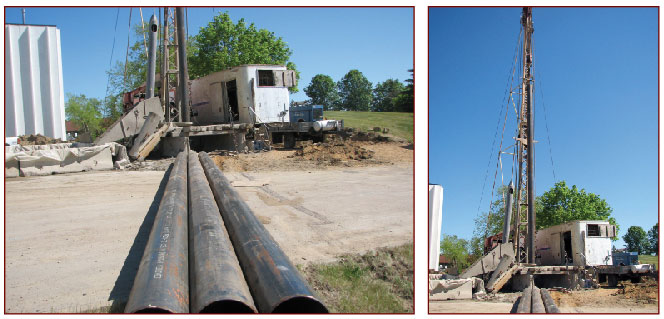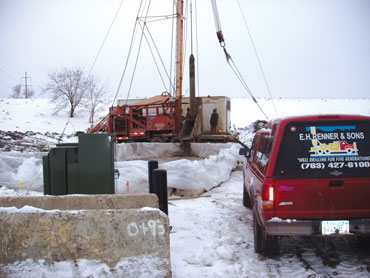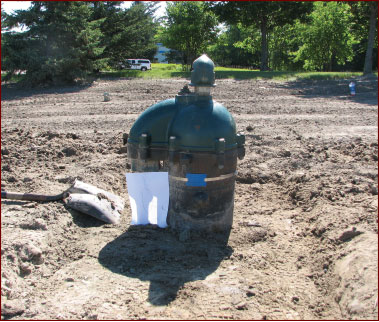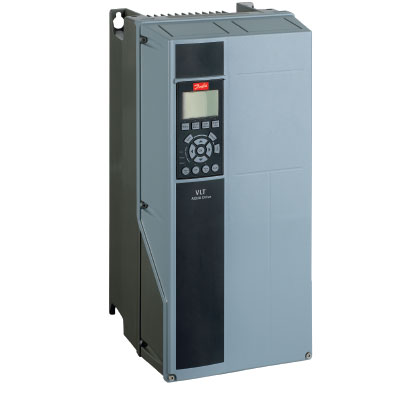VLT® AQUA Drive produces huge water savings from food processor’s deep well
Food processing plants require a dependable source of water in large quantities for the washing and rinsing, steaming, cooking and cooling of food, and during plant sanitation operations. That’s why a large Midwest food processor wanted full control over its water supply by constructing a private water well on its own property. However, what looked like a simple solution was quite complex below the surface—as the well driller discovered when he embarked on the project.
“The food processor’s water production requirements and the utilization of local wells meant our first and second drilling choices wouldn’t work,” says Roger Renner, owner of E.H. Renner and Sons, a leading well-drilling firm located in Elk River, Minnesota, near the Twin Cities metro area. “In fact, I’m the fourth generation in our family firm, and I can truly say this was the most challenging job I’ve ever had.”
DIFFICULTIES WITH A DEEP AQUIFER
From the start, Renner realized the project would be difficult when there were objections to using a desirable shallow aquifer. An aquifer is a water-bearing layer of permeable sand, gravel or rock that channels water to a well. In this case, the first choice aquifer—a shallow sand and gravel formation located from 112 to 442 feet (34.14 to 134.72 meters) deep—could not be used, because local residents were concerned that their wells would dry up.

“That meant we had to look at deeper aquifers in two geological formations known as the Jordan formation and the Franconia-Ironton-Galesville (FIG) formation,” says Renner. “A nearby city was drawing water out of the Jordan formation. That forced the processing plant to go deeper—down 705 feet (214.88 meters), over a tenth of a mile. At that depth, the bedrock is the FIG formation, which dates to the Cambrian Era. This water was deposited millions of years ago before the dinosaur age. Yet, the water quality is generally acceptable for all types of use today.”
Although drilling a deep well is difficult, Renner’s main challenge was that the FIG formation has extremely low well productivity, which was measured at a specific capacity of 1 to 2 gallons (3.79 to 7.57 liters) per foot of drawdown – compared to a specific capacity of 20 gallons (75.71 liters) per foot drawdown in the sand and gravel formation. Also, the FIG formation would max out at a relatively low 350 gallons (1324.89 liters) per minute. The food processing plant’s operation, however, needs a dependable 350 GPM flow rate running 24 hours a day, 7 days a week. That adds up to 10 to 12 million gallons (37.9 to 45.4 million liters) per month, 150 million gallons (567.8 million liters) per year—a larger volume of water than used by small cities.
“The plant depends on that rate of flow to process food around the clock all year long,” Renner emphasizes. “At the same time, we had to respect the low specific capacity to avoid over pumping the well and prevent excessive drawdown. Plus, the state Department of Natural Resources requires the pumping water level to be monitored and controlled to keep the pumping water level above the existing horizon of the formation. That meant we needed an intelligent pump control system that could monitor and adjust a lot of different factors to ensure reliable water production.”
VFD INTELLIGENCE AT WORK
Considering the challenges, Renner contacted Brian Peterson of Schwab, Vollhaber and Lubratt, Inc., (SVL) of Shoreview, Minnesota, near St. Paul. As a provider of technical and engineering services for HVAC and pump applications, Peterson recommended a Danfoss VLT® AQUA Drive to operate the pump motor.

“This facility is extremely dependent on maintaining a variable water flow between 150 to 350 gallons (567.81 to 1324.89 liters) per minute at a constant pressure of 65 pounds per square inch (psi),” says Peterson. “The Danfoss VLT® AQUA Drive is a variable frequency drive (VFD) that is built in Loves Park, Illnois, and is specifically dedicated to water and wastewater applications. They come off the shelf with the onboard intelligence to handle all the monitoring and control parameters this job required.”
The VFD was employed in a closed control loop. The control and monitoring programming included
A wake-sleep sequence that, upon waking, ramps up the GPM of the pump to provide a minimum flow of water to cool the motor. As the plant needs more water flow, the VFD increases motor speed to the required pre-set pressure of 65 psi. The typical production flow rate is 185 to 285 gallons (567.81 to 1078.84 liters) per minute, with process cleaning peaking at the 350 gallons (1324.89 liters) per minute limit.
To control the flow rate, the VFD monitors a pressure transducer that sends a 4-20mA signal back to the drive. The drive intelligence ensures a constant 65 psi, but also limits the flow to 350 gallons (1324.89 liters) per minute by monitoring the flow meter. Even with fluctuating pumping levels over the 12-month period the VFD adjusts the speed of the motor to compensate for the changing pumping levels. During the initial VFD programming, adjustments were made that limited the 100 horsepower motor to only 56 Hz to avoid possible over pumping in the event of a water main break.
A pressure transducer was also installed in the well to control the maximum amount of water drawdown. If the pumping water level in the well falls below the preset 520-foot (158.5 meter) depth, the VFD would limit or hold the speed of the pump to avoid severe pump damage created by cavitation. This over pumping mode protection feature is particularly needed in the autumn when well pumping levels are lowest and when the processing plant’s production is at its peak.
Finally when plant water demand falls below the minimum GPM needed to cool the submersible motor, the VFD stops the pump and enters the sleep cycle. When the plant calls for water while the VFD is in the sleep state, the water pressure falls below a preset minimum pressure of 50 psi, then restarts the pump and ramps up to the preset 65 psi. Thus, the wake/sleep sequence protects the motor against overheating if the minimum flow rate cannot be maintained and shuts off the flow when the plant does not call for water.
Peterson notes that “the VFD’s extended closed loop function can handle three distinct control sensors: the flow meter, drawdown gauge and the pressure. The VLT® AQUA Drives built-in intelligence can process all those inputs simultaneously. Plus, the system incorporates phase failure protection, under-voltage and over-voltage protection that protects the drive and the submersible motor, pump and bearing. This protection can provide some water production even with a loss of a three-phase power down to two-phase current.”
The plant is so dependent on maintaining water flow that the customer also added an identical VFD housed in a NEMA 1 enclosure. It hangs on a wall inside the plant, beside the original Danfoss VLT® AQUA Drive.
“The spare is a redundant backup,” says Peterson. “If there were a catastrophic failure due to a utility issue, lightning, physical damage or other unforeseen event, the spare drive can be put into service by just a flip of the switch. For the same reason, the plant also wanted a replacement submersible motor and pump on the shelf. But the system has been so reliable since it went into service in 2010 that the redundant measures have not been needed.”
GIGANTIC PAYBACK, PLUS GREAT SUPPORT
Along with reliable water production, the processing plant benefited from tremendous water savings by operating its own well.
“Maintaining variable flow at a constant pressure of 65 psi is job number one,” says Renner. “The reliability of the VLT® AQUA Drive is critical to keep this plant running. Plus, by enabling the use of their own water source, the VLT® AQUA Drive makes it possible to run the plant very profitably.”
Renner calculates that the plant consumes about 12 million gallons (45.4 million liters) a month. If they did not have their own well and were paying a local price of about two dollars per 1000 gallons (3785.41 liters), the water cost alone would have been $24,000 a month, nearly $250,000 dollars a year.

For a processing plant whose business depends on high, reliable quantities of water, “Saving a quarter of a million dollars a year certainly justifies a complex well project like this, because the payback is so fast,” Renner concludes. “The well has been operating since 2010. The entire project, including well drilling and lining, was paid back in less than two years.”
“And SVL and Danfoss have been a pleasure to work with. The level of support was unbelievable. All of the parameters required a lot of programming. If we had an issue, the Danfoss application engineer was available, even on a Sunday. It’s hard to find that level of support in a VFD manufacturer. The Danfoss team was instrumental in making this project a huge success.”
■ ■ ■
[divider]
ABOUT THE AUTHOR
James Klauer is regional sales manager for Danfoss, a world leader within energy-efficient and climate-friendly solutions for selected industries. For more information, visit www.danfoss.com.
MODERN PUMPING TODAY, June 2014
Did you enjoy this article?
Subscribe to the FREE Digital Edition of Modern Pumping Today Magazine!


